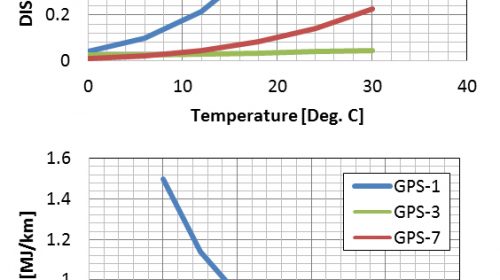In its “PVI Mechanistic Model Gen II” research brief (December 2013) CSHub extends earlier observation of pavement-vehicle interaction, which impacts truck fuel consumption and, in turn, concrete and asphalt life cycle assessment. The new model can account for the impact of temperature and vehicle speed, plus other pavement structural and material properties, on fuel consumption, and is thereby applicable to viscoelastic (e.g. asphalt concrete) pavements. Model Gen II provides what CSHub staff affirms is “a rigorous tool for comparative studies and LCA of the roadway network.”
Model Gen II charts dissipated energy due to deflection for three pavement types in the Federal Highway Administration’s Long Term Pavement Performance database: GPS-1 (asphalt concrete on granular base), GPS-3 (jointed plain concrete), and GPS-7 (asphalt concrete over concrete). The dissipated energy due to pavement deflection, which relates to excess fuel consumption, increases with temperature and decreases as the vehicle speed increases. Variations in excess fuel consumption due to temperature and vehicle speed changes are significant for GPS-1, moderate for GPS-7 and negligible for GPS-3 sections.
